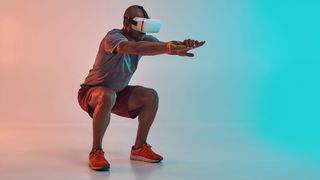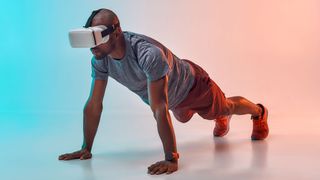How to get fit in the metaverse
Immersive worlds will get you moving

What's going to be the killer app for the metaverse? Video calling, virtual meetings and gaming are bound to feature, but there's another more unexpected activity that just may help give some momentum to the complicated concept of interconnected and virtual communities – virtual workouts.
Some visions of the metaverse appear to hang on the willingness of people to spend many hours behind VR headsets existing as avatars in virtual worlds. That seems unlikely.
Short interactions in places where VR and AR hardware exist could be much more desirable; immersive video calls in a home office, a gaming session in the living room, or a virtual workout in a metaverse-equipped gym or health club, or at home.
In short, more engaging fitness activities within a digital space, either done alone or with others. Cue the immersive gamification of fitness.
What are virtual workouts?
Bored of running the same old route around your local park? You've probably used a running machine in a gym that shows you – on a tiny 10-inch screen – a simple CGI landscape of a forest, a beach or a riverside path that you virtually 'run' through.
You can see the same thing in stationary bike company Peloton's Scenic Rides feature. In the metaverse that kind of experience is going to be massively more impressive.
Think dynamic 360º landscapes, complete with audio, where you run with others, possibly even live-action avatars of your running buddies.
Get daily insight, inspiration and deals in your inbox
Get the hottest deals available in your inbox plus news, reviews, opinion, analysis and more from the TechRadar team.
A virtual workout could be done either alone or as part of an interconnected group at home without too much equipment. Think HIIT training, a sweat session or a yoga class with an instructor who could be real – or, rather, an avatar of someone real – or could be an AI.
You could virtual play tennis, box with or play chess with someone anywhere on the planet … or you could go head-to-head with an AI.
Does a fitness metaverse already exist?
The metaverse proper doesn't exist yet and nobody is sure what it will actually entail – and what hardware will be needed – but there's already a trend for fitness in VR that has one eye on the metaverse.
What brands in the fitness industry are trying to do is take their fitness classes into the non-physical world.
There are already a bunch of fitness apps for VR headsets, such as FitXR, Holofit and Within's Supernatural. Group fitness brand Les Mills also recently announced that its Bodycombat workout is becoming a VR gaming app on Odders Labs' Quest Platform.
Its customers will be able to take on challenges while in immersive worlds resembling everything from a Martian desert to ancient Rome.

Fitness brands are embracing the metaverse
There's also now an emerging trend for new digital universes focused on fitness brands.
Nike recently unveiled Nikeland on the Roblox online gaming platform. An immersive virtual space where Nike fans can compete and – you guessed it – buy Nike products, you can go for a virtual swim or play dodge-ball in Nikeland.
Body movements in the real world are taken online using the accelerometers in smartphones. It's not that different to the old nunchucks used by the Nintendo Wii.
Meanwhile, Adidas has entered The Sandbox, an immersive fitness platform created by OliveX, which already hosts fitness content from Adidas and Team GB.
OliveX recently signed-up fitness studio brand TRIB3 – which promises that it will be possible for someone to go running in their metaverse alongside avatars of their friends – as well as fitness gear brand Gym Aesthetics and outdoor play company PlayInnovation.
So think celebrity-led fitness classes, branded content and earn-as-you-sweat fitness sessions and games to get you hooked on moving in the metaverse.
The future of fitness in the metaverse
The global fitness industry is huge, rated at almost $100 billion each year. It's also a sector where both monthly subscription fees are the norm and where the pandemic has normalized the idea of fitness at home.
So there might just be a business model that can adapt to the metaverse future. Either way, expect dozens of other fitness brands to move into the metaverse as fitness becomes an immersive digital experience.
Jamie is a freelance tech, travel and space journalist based in the UK. He’s been writing regularly for Techradar since it was launched in 2008 and also writes regularly for Forbes, The Telegraph, the South China Morning Post, Sky & Telescope and the Sky At Night magazine as well as other Future titles T3, Digital Camera World, All About Space and Space.com. He also edits two of his own websites, TravGear.com and WhenIsTheNextEclipse.com that reflect his obsession with travel gear and solar eclipse travel. He is the author of A Stargazing Program For Beginners (Springer, 2015),


